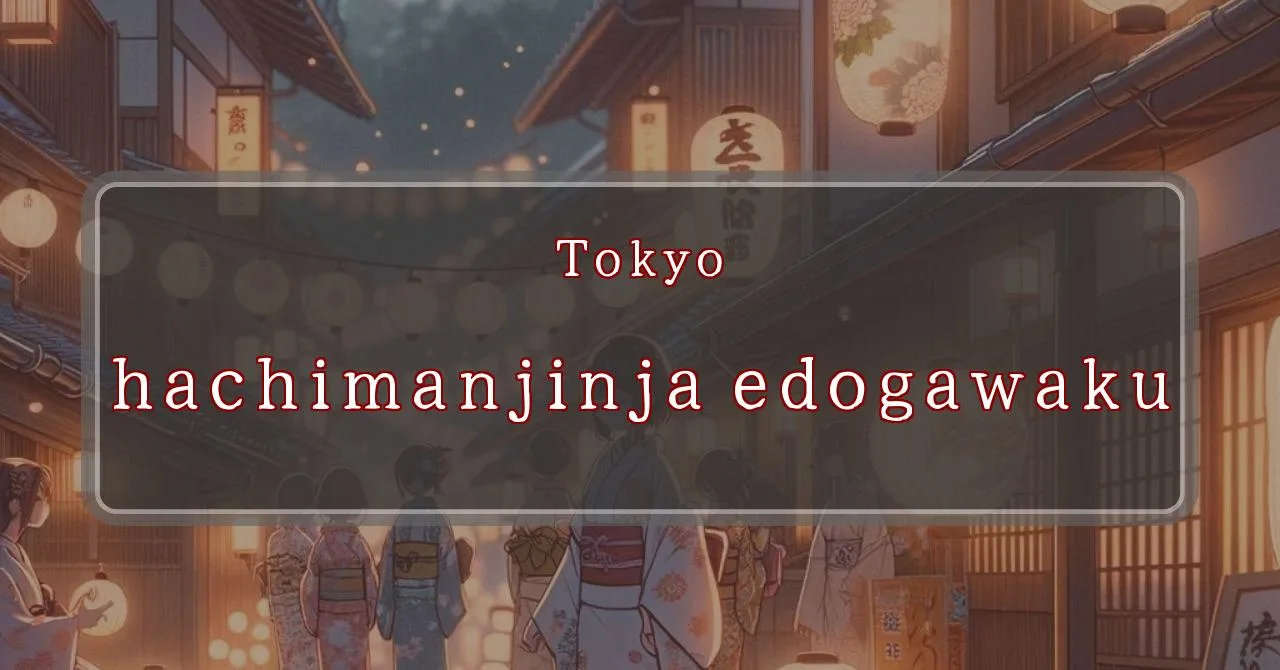Gleaming lights dance at Hachiman Shrine
Basic Information
Hachiman Shrine is a Shinto shrine located in Edogawa Ward, Tokyo, Japan. It is dedicated to the god Hachiman, the god of war and archery. The shrine was founded in 1624 and is one of the most popular shrines in Edogawa Ward.
- Address: 2-1-26 Nishikasai, Edogawa-ku, Tokyo 134-0088
- Phone Number: 03-3680-1555
- Access: 11-minute walk from Nishikasai Station on the Tozai Line
- Festival Days: August 19th (Tue) – August 20th (Wed), 2024
Main Events and Attractions of the Festival
The Hachiman Shrine Festival is a lively and colorful event that attracts many visitors each year. The main events and attractions of the festival include:
Mikoshi Procession
The mikoshi procession is the highlight of the Hachiman Shrine Festival. A mikoshi is a portable shrine that is carried through the streets by a team of people. The mikoshi is believed to be the temporary home of the shrine’s deity, and it is carried through the streets to bless the community.
Kagura Performance
Kagura is a traditional Japanese dance and music performance that is often performed at Shinto shrines. During the Hachiman Shrine Festival, kagura is performed by a group of trained dancers and musicians. The performance tells the stories of the gods and goddesses of Shinto, and it is a beautiful and moving experience.
Bon Odori Dance
Bon Odori is a traditional Japanese folk dance that is performed during the Obon festival. During the Hachiman Shrine Festival, Bon Odori is performed by a group of people in traditional Japanese clothing. The dance is simple and easy to learn, and it is a great way to experience Japanese culture.
Food Stalls
There are many food stalls at the Hachiman Shrine Festival, selling a variety of delicious Japanese food. Some of the most popular foods include yakitori (grilled chicken), takoyaki (octopus balls), and taiyaki (fish-shaped cakes filled with sweet red bean paste).
Games and Activities
There are also a number of games and activities for children at the Hachiman Shrine Festival. These include things like goldfish scooping, ring toss, and face painting.
Blessings and Deities
Hachiman Shrine is dedicated to the god Hachiman, the god of war and archery. Hachiman is also known as the protector of warriors and the patron deity of the Minamoto clan, which ruled Japan from the 12th to the 14th centuries. Hachiman is often depicted as a samurai warrior, and he is revered for his courage, strength, and loyalty.
- Hachiman: God of war and archery, protector of warriors, patron deity of the Minamoto clan
- Depiction: Samurai warrior
- Revered for: Courage, strength, loyalty
Origin and History
The origins of Hachiman Shrine are unclear, but it is believed to have been founded in the 17th century. The shrine was originally located in a different part of Edogawa Ward, but it was moved to its current location in 1929. Hachiman Shrine has been a popular place of worship for centuries, and it is especially popular among people who are seeking success in battle or in business.
- Founded: 17th century
- Original location: Different part of Edogawa Ward
- Moved to current location: 1929
- Popularity: Place of worship for centuries, especially among those seeking success in battle or business
Tips and Notes for Visitors
If you are planning to visit Hachiman Shrine during the festival, here are a few tips and notes to keep in mind:
- Wear comfortable shoes: You will be doing a lot of walking, so make sure to wear comfortable shoes.
- Bring cash: Many of the food and game stalls at the festival only accept cash.
- Be prepared for crowds: The festival is very popular, so be prepared for large crowds.
- Be respectful: Hachiman Shrine is a religious site, so be respectful of the people who are there to worship.
Parking Information
There is no parking lot at Hachiman Shrine, but there are several public parking lots nearby. The closest parking lot is located about a 5-minute walk from the shrine.
- No parking lot at Hachiman Shrine
- Public parking lots nearby
- Closest parking lot: 5-minute walk from the shrine
Popular Stalls and Food Carts in Recent Years
| Type of Stall | Description |
|---|---|
| Takoyaki | A staple at Japanese festivals. Characterized by a crispy outside and a creamy inside. |
| Jaga Butter | A simple yet popular snack of hot potatoes lavishly topped with melted butter. |
| Baby Castella | Small castella cakes, sweet and fluffy treats enjoyed by children and adults alike. |
| Grilled Ayu with Salt | Fresh ayu fish grilled whole with salt, a savory taste of Japanese summer. |
| Shaapin | A unique gourmet item influenced by foreign cuisine, with a chewy skin wrapping the filling. |
| Okonomiyaki | A Japanese grilled dish where you often choose your own ingredients for a personalized flavor. |
| Cotton Candy | A fluffy, sweet snack that’s extremely popular with children. |
| Chocolate Banana | A banana coated in chocolate, a fun and visually appealing dessert. |
| Kushiyaki | Various types of ingredients skewered and grilled, an easy-to-enjoy snack. |
| Yakisoba | Fried noodles mixed with a special sauce, a fast food favorite in Japan. |



